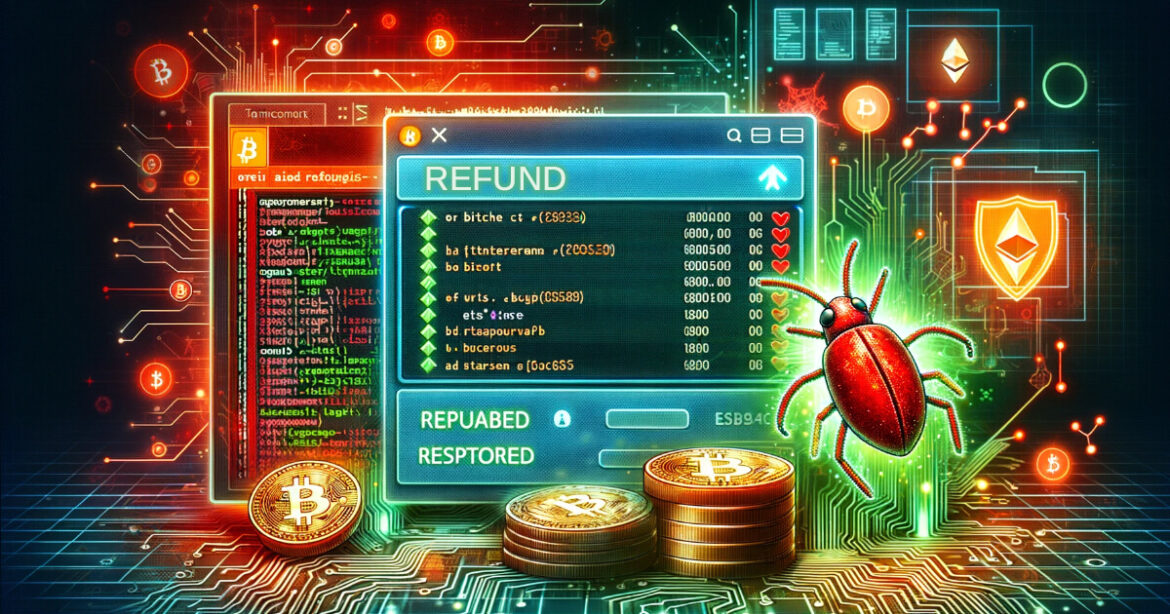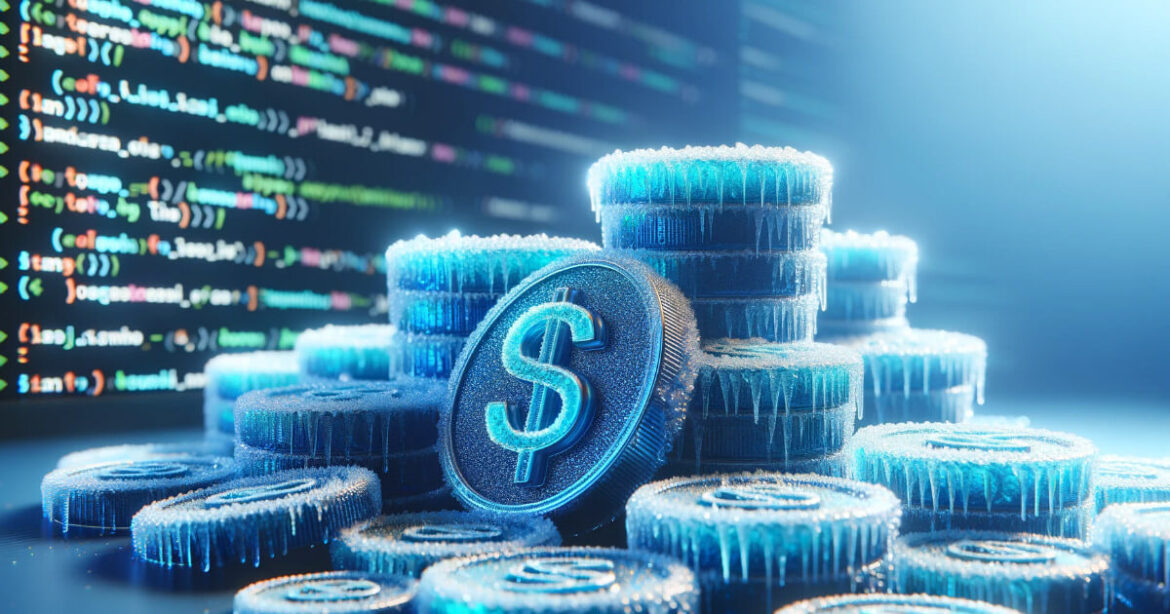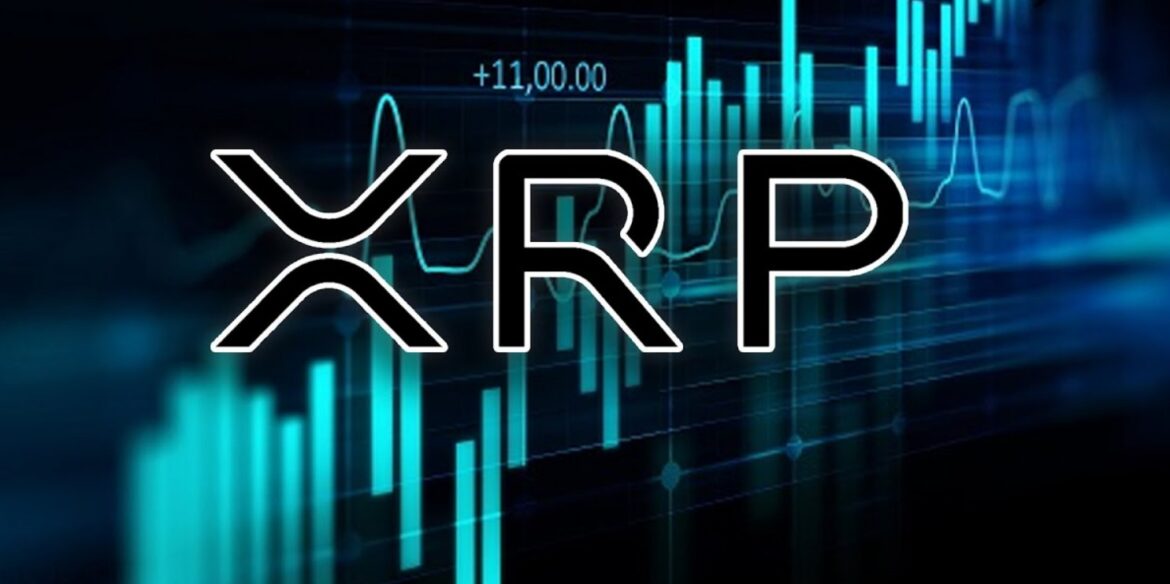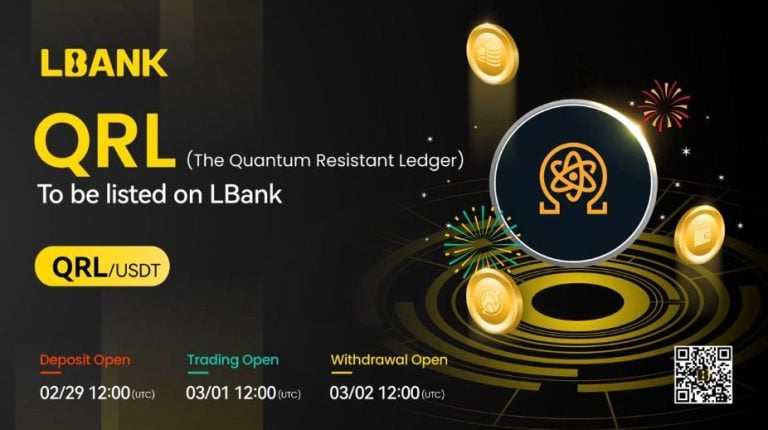 PRESS RELEASE. Road Town, BVI, February 29th, 2024 – In a significant move for cryptocurrency and mobile technology enthusiasts, LBank Exchange, a premier global digital asset trading platform, has announced the listing of The Quantum Resistant Ledger (QRL) on March 1, 2024. Users of LBank Exchange can brace themselves for the QRL/USDT trading pair, which […]
PRESS RELEASE. Road Town, BVI, February 29th, 2024 – In a significant move for cryptocurrency and mobile technology enthusiasts, LBank Exchange, a premier global digital asset trading platform, has announced the listing of The Quantum Resistant Ledger (QRL) on March 1, 2024. Users of LBank Exchange can brace themselves for the QRL/USDT trading pair, which […]
Source link
Ledger
XRP Ledger (XRPL) Token Market Cap Surged 47% In Q4 To $169M: What Caused The Surge?
A recent report by Messari sheds light on the state of the XRP Ledger (XRPL) and its notable performance during the fourth quarter (Q4) of 2023.
The report highlights significant milestones, including its native token market capitalization, distribution, burning mechanism, price movement, legal battle, and network activity.
Distribution Of 4 Billion XRP Contributes To Market Cap Growth?
As of Q4 2023, XRP, the native token of the XRPL, emerged as the sixth-largest cryptocurrency by market capitalization, reaching $33.7 billion. The token’s circulating market cap witnessed a substantial 21.2% increase quarter-over-quarter (QoQ) and an impressive 93.6% growth year-over-year (YoY).
According to Messari, the increase in market capitalization was primarily due to the distribution of 4 billion XRP and a significant price spike on November 13, when the token reached as high as $0.7503.

Throughout 2023, 4 billion tokens were distributed, accounting for 8% of the XRP supply from the end of 2022. While this distribution contributed to the increase in market cap, it was overshadowed by the impact of the price spike.
Additionally, the XRPL employs a transaction fee-burning mechanism, applying deflationary pressure to the total supply of 100 billion XRP. However, the low transaction fees on the network have resulted in a relatively low burn rate of approximately 12 million XRP since the inception of the XRP Ledger.
Network Activity Shows Mixed Trends In Q4 2023
Q4 2023 marked a significant turning point for XRP, concluding a multi-year legal battle with the US Securities and Exchange Commission (SEC). In July 2023, the district court ruled that XRP is not considered an investment contract or a security, distinguishing it from many other blockchain assets.
This ruling triggered a surge in XRP’s price, with an increase of over 70% on July 14 and a peak of $0.82 on July 20. The subsequent relisting of XRP on major cryptocurrency exchanges further bolstered its position.
Network activity on the XRPLedger displayed mixed trends in Q4. While active addresses decreased by 31.3% QoQ, transactions increased by 22.7% QoQ.
Notably, a significant portion of transaction activity originated from a group of accounts sending transactions to a single account for inscription-related activity. The number of accounts on the XRPL increased by 188,000, reaching 5.00 million in Q4.
Overall, the Q4 2023 report on the XRP Ledger showcases its growth, driven by various factors such as price spikes, legal victories, and network activity. With its expanding market capitalization and increasing adoption, XRP continues to solidify its position in the cryptocurrency market.
Featured image from Shutterstock, chart from TradingView.com
Disclaimer: The article is provided for educational purposes only. It does not represent the opinions of NewsBTC on whether to buy, sell or hold any investments and naturally investing carries risks. You are advised to conduct your own research before making any investment decisions. Use information provided on this website entirely at your own risk.
XRP Ledger, created by Ripple Labs Inc., is an open-source blockchain technology and digital asset. This means that developers can contribute to its development and enhance its functionality. XRP serves as the native cryptocurrency of the XRP Ledger and is the commonly recognized name for it. The XRP Ledger is purposefully designed to enable swift, cost-effective, and secure transactions. It functions as a distributed ledger, where transaction records are stored across a network of validators, which are participating computers, ensuring the integrity of the ledger.
XRP has garnered significant recognition for its ability to facilitate expeditious and streamlined cross-border payments. Its primary objective is to enhance liquidity and establish connections between diverse currencies, enabling seamless value transfers for both financial institutions and individuals across international borders. Ripple, the entity responsible for XRP, has forged partnerships with numerous financial institutions to investigate the potential of XRP in the realms of remittances and international settlements.
It is imperative to emphasize that although XRP is commonly linked with Ripple, the XRP Ledger functions autonomously, separate from the company. XRP can be exchanged on different cryptocurrency platforms and stored in digital wallets that are compatible with the XRP Ledger.
Additionally, there is a diverse range of cryptocurrency exchanges that support the XRP Ledger (XRP) for individuals interested in buying, selling, or trading XRP. Some notable examples include Binance, Coinbase, Kraken, BitStamp, Huobi, and more.
Founders Of XRP Ledger (XRP)
In early 2011, developers David Schwartz, Jed McCaleb, and Arthur Britto were intrigued by Bitcoin but concerned about its energy consumption and scalability issues. They aimed to create a more sustainable system for value transfer. Their predictions about Bitcoin’s energy usage were proven right when estimates revealed that Bitcoin mining consumed more energy than Portugal in 2019. They also foresaw the risks of one miner or collusion of miners gaining over 50% of the mining power, which remains a concern today as mining power concentrates in China.
Undeterred, the developers continued their work and created a distributed ledger called Ripple, with a digital asset initially called “ripples” (later referred to as XRP). The name Ripple encompassed the open-source project, the unique consensus ledger (Ripple Consensus Ledger), the transaction protocol (Ripple Transaction Protocol or RTXP), the network, and the digital asset.
To eliminate confusion, the community started referring to the digital asset as “XRP.” By June 2012, Schwartz, McCaleb, and Britto completed the code development and finalized the Ledger.

How XRP Ledger (XRP) Works
The XRP Ledger represents a pioneering blockchain technology that places a strong emphasis on scalability and interoperability. This focus enables the ledger to offer a wide array of possibilities for diverse applications that surpass the realms of traditional financial systems.
By demonstrating the capacity to handle substantial transaction volumes and foster seamless connectivity among different assets, the XRP Ledger stands poised to bring about a revolution across multiple industries and ignite innovation. Its scalable and interoperable nature creates opportunities for novel use cases and transformative solutions within the blockchain ecosystem.
Prominent Features Of XRP Ledger
Consensus Ledger
Functioning as a distributed and decentralized ledger, the XRP Ledger stores the transaction history across an independent network of validators. Every validator preserves a copy of the ledger, and transactions undergo validation and agreement via the consensus algorithm. This approach ensures that the ledger’s transaction history is securely stored and that transactions are verified and approved through a collaborative process among validators. By employing this distributed and decentralized framework, the XRP Ledger establishes a reliable and transparent system for recording and validating transactions.
Gateways and Interoperability
The XRP Ledger enables the establishment of gateways, which are entities responsible for issuing and redeeming assets on the ledger. These gateways play a crucial role in bridging various currencies and assets, fostering seamless interoperability across different financial systems.
By facilitating the transfer and exchange of diverse assets, the gateways enhance the connectivity and compatibility between different forms of value representation. This feature of the XRP Ledger promotes greater efficiency and accessibility in cross-border transactions and opens up opportunities for enhanced liquidity and streamlined financial operations.
Transaction Speed and Scalability
Engineered with scalability and rapid transaction settlement in mind, the XRP Ledger (XRP) is adept at processing a substantial number of transactions per second. With the capability to settle transactions within a matter of seconds, the ledger is well-suited for a wide range of use cases that demand swift and efficient transaction execution.
Its high scalability and speedy transaction settlement empower businesses and individuals alike to conduct seamless and timely transactions, fostering enhanced productivity and responsiveness in various applications and industries.
Consensus Algorithm
Within the XRP Ledger, a distinctive consensus algorithm known as the Ripple Protocol Consensus Algorithm (RPCA) is employed. Diverging from conventional proof-of-work (PoW) or proof-of-stake (PoS) algorithms, RPCA relies on a group of trusted validators to authenticate and validate transactions. These validators assume the crucial role of collectively establishing consensus regarding the sequence and legitimacy of transactions on the network. By leveraging this innovative consensus mechanism, the XRP Ledger ensures the integrity and reliability of its transaction validation process, providing a secure and efficient environment for conducting business.
Native Cryptocurrency (XRP)
XRP operates as the inherent digital currency of the XRP Ledger, serving multiple purposes, such as facilitating transactions, offering liquidity, and bridging diverse currencies. As a medium of value exchange, XRP can be transferred between various entities on the XRP Ledger, enabling seamless transactions and facilitating the exchange of value. This versatile cryptocurrency plays a vital role in supporting the functionality and efficiency of the XRP Ledger ecosystem.
The Impact Of XRP On The Financial Industry
Undoubtedly, the XRP Ledger, along with its native currency XRP, has made a notable impact on the financial industry, bringing forth a range of positive innovations across various important aspects such as:
Decentralized Finance (DeFi)
The XRP Ledger’s utilization of smart contracts and tokenization creates possibilities for decentralized finance (DeFi) applications, paving the way for the development of groundbreaking financial services like lending, borrowing, and decentralized exchanges. With its rapid and scalable nature, the XRP Ledger provides an ideal foundation for constructing DeFi applications, potentially extending financial services to underserved communities and diminishing dependence on conventional intermediaries.
Asset Tokenization
The capacity of the XRP Ledger to tokenize tangible assets like real estate, art, and commodities has the potential to unleash liquidity for assets that have historically lacked it. Through the representation of these assets as digital tokens on the ledger, fractional ownership becomes feasible, enabling enhanced accessibility and transferability. This breakthrough can introduce fresh investment prospects and enhance market efficiency.
Cross-Border Payments
The swift transaction settlement and economical fees offered by the XRP Ledger make it an attractive choice for cross-border payments. Its efficient currency-bridging capabilities simplify and expedite international transactions, potentially reducing expenses and enhancing liquidity for financial institutions. This can result in expedited and cost-effective remittances, benefiting both businesses and individuals.
Liquidity and Market Efficiency
The XRP Ledger’s utilization of XRP as a bridge currency and liquidity tool has the potential to bolster market efficiency and enhance liquidity for diverse assets. By enabling seamless value exchange across different currencies, the XRP Ledger contributes to improved market liquidity, simplifying the process of buying, selling, and trading assets for users. This heightened liquidity has the capacity to foster more efficient markets and enhance the process of price discovery.
XRP Distribution And Price Dynamics
The distribution of XRP tokens by Ripple Labs is a nuanced process that goes beyond a simple monthly release schedule. Currently, the majority of XRP is held in 16 escrow contracts, and their release is influenced by multiple factors, such as market conditions and ecosystem adoption. The original 55-month distribution projection was an estimate, and Ripple has the ability to adjust the pace based on their assessment.
Certainly, this distribution strategy impacts the price of XRP. A significant influx of XRP could potentially exert downward pressure on its value. However, attributing price fluctuations solely to this factor would be narrow-minded. The overall market sentiment towards cryptocurrencies, demand from financial institutions, regulatory developments, and news related to Ripple all contribute significantly. To truly understand the price action of XRP, a comprehensive analysis of these intertwined factors is necessary, recognizing the intricate interplay between Ripple’s distribution strategy and the dynamic cryptocurrency landscape.
Tokenomics Of XRP Supply
XRP has a fixed supply of 100 billion tokens, making it a pre-mined cryptocurrency with no possibility of additional token creation. Only a fraction of the tokens are actively traded, while 20 billion went to the founders. The distribution involves 55 smart contracts that release 1 billion tokens monthly over 55 months, resulting in a monthly increment of 1 billion tokens. The circulating supply is around 53.7 billion tokens, with the remaining held in escrow.
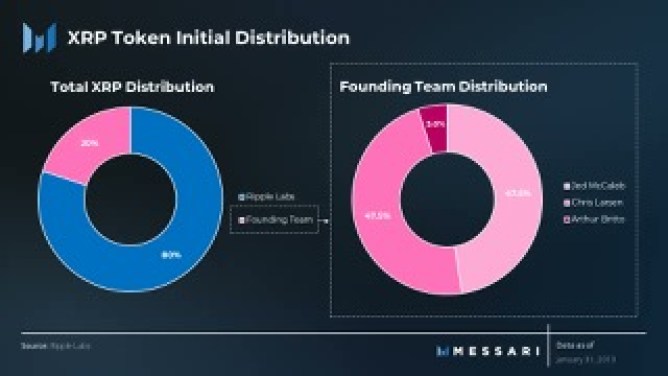
Source: Messari on X
Over 60% of the total supply is concentrated in the top 100 wallets, raising decentralization concerns. Ripple owns 6.5 billion XRP, adjusting the circulating supply to approximately 47 billion tokens.
XRP exhibits a mild deflationary trend from burning fees, reducing the total supply to about 99,988,221,902 XRP.
Buying XRP Coins
Purchasing XRP coins can be a relatively straightforward procedure; however, the available choices cater to diverse levels of experience and comfort. Here is a breakdown of different approaches tailored to meet your specific requirements:
Beginner-Friendly Exchanges
Coinbase and Binance are user-friendly platforms suitable for newcomers. They provide intuitive interfaces, clear instructions, and customer support to assist users throughout the process.
Peer-to-Peer (P2P) Exchanges
Platforms like Paxful are P2P exchanges that enable direct XRP purchases from other individuals. This decentralized approach offers privacy and flexibility but requires caution when evaluating counterparties and following safety measures.
Decentralized Exchanges (DEX)
Uniswap is an example of a DEX platform that operates on blockchains. They facilitate direct peer-to-peer trading without intermediaries, providing enhanced security and control over funds. However, using DEX platforms will require compatible wallets.
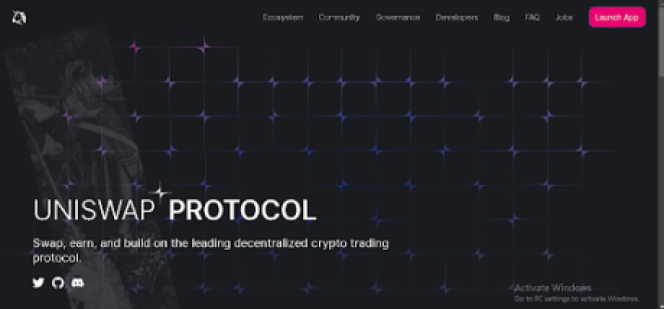
Tracking Prices of XRP Ledger (XRP)
To effectively track the prices of XRP Ledger (XRP), the digital asset native to the XRP Ledger, and stay up to date with its market movements and fluctuations, there are several reliable methods and platforms that you can utilize, such as widely recognized cryptocurrency tracking platforms like CoinMarketCap
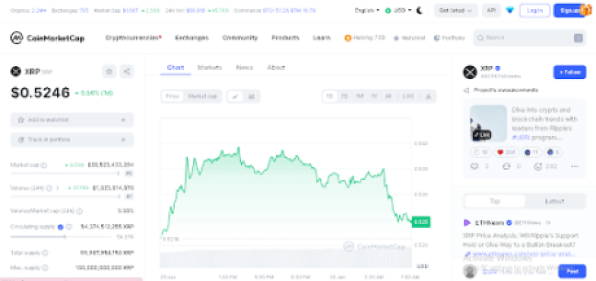
CoinMarketCap is a highly regarded platform for monitoring cryptocurrencies, offering extensive data on a diverse range of digital assets, such as XRP Ledger (XRP). Users can explore the XRP page on CoinMarketCap to access up-to-the-minute price updates, historical data, market trends, and other pertinent information relating to XRP. CoinMarketCap serves as a trusted resource for individuals seeking to track and analyze the performance of XRP Ledger within the global cryptocurrency market.
Ripple Lawsuit With Securities And Exchange Commission (SEC)
The Ripple vs. SEC legal dispute, which began in December 2020, has a profound impact on XRP. The SEC accuses Ripple of conducting an unregistered securities offering through XRP sales, while Ripple argues that XRP is a utility token for cross-border payments and not a security. This ongoing battle has caused turbulence for XRP, resulting in price volatility and adoption uncertainty. The outcome of the case will have significant implications for XRP and the broader cryptocurrency industry.
The lawsuit has led to a hesitant market as businesses and individuals are cautious about embracing XRP due to the uncertainty surrounding its classification. The resolution will determine whether XRP’s utility as a token will prevail or if the SEC’s classification as a security will cast a long shadow over its future. As the market awaits a definitive answer, the trajectory of Ripple’s digital creation remains uncertain.
Conclusion
XRP Ledger (XRP) boasts an established name, a decentralized network, and lightning-fast, low-cost transactions. This has cemented its role as a preferred bridge currency for cross-border payments.
Despite facing legal challenges, XRP has an impressive track record as one of the pioneering cryptocurrencies, gaining widespread adoption among major financial institutions through RippleNet. The community’s dedication and the project’s foundational strengths provide a solid basis for potential success. However, the outcome of the SEC lawsuit will be a crucial determinant in shaping the future of XRP, whether it will be positive or negative.
Nevertheless, navigating the world of XRP necessitates careful consideration. While some may prioritize user-friendly platforms for entry, experienced traders might seek advanced features offered by decentralized exchanges (DEXs).
Regardless of your experience level, remember that cryptocurrencies remain volatile, and responsible investing practices are paramount. Consider these factors, research, and choose the path that aligns with your personal financial goals and risk tolerance.
Disclaimer: The article is provided for educational purposes only. It does not represent the opinions of NewsBTC on whether to buy, sell or hold any investments and naturally investing carries risks. You are advised to conduct your own research before making any investment decisions. Use information provided on this website entirely at your own risk.
Ledger pledges full compensation for victims of $600k ConnectKit exploit

Hardware wallet provider Ledger has announced it will fully reimburse users impacted by the vulnerability that compromised its ConnectKit library last week.
Additionally, the firm promised to disable blind signing—a process where users approve transactions without verifying their content—on its devices for Ethereum virtual machine (EVM)-compatible decentralized applications (dApps) by June 2024.
$600k stolen
In a Dec. 20 statement on X (formerly Twitter), the firm revealed that its ConnectKit library compromise resulted in the theft of approximately $600,000 in digital assets from users who blind-signed on EVM dApps.
Ledger affirmed its commitment to compensating the affected individuals by February 2024 and disclosed its active engagement with these users.
On Dec. 14, CryptoSlate reported that Ledger’s ConnectKit library was hacked by attackers who replaced a genuine version with a malicious file that redirects funds to a wallet controlled by the hacker.
The breach impacted several prominent DeFi projects, including SushiSwap, which immediately advised their users not to interact with the frontend of their websites.
Bolstering security
While Ledger immediately pushed an update to rectify the situation, the firm has further pledged to continue its focus on bolstering security measures to safeguard the ecosystem and prevent future occurrences.
As part of this commitment, Ledger intends to collaborate with the dApp ecosystem to implement Clear Signing—a process allowing users to verify all transaction details before approving them—and phase out the Blind Signing feature from its devices by June 2024.
“Our commitment is to work with the community and DApp ecosystem to allow Clear Signing so users can verify all transactions on Ledger devices before signing. This will lead to a new standard to protect users and encourage Clear Signing across DApps,” Ledger wrote.
According to the firm, Clear Signing will empower users to verify all transactions on their devices before signing, serving as an effective measure to mitigate front-end attacks on cryptocurrency platforms.
It added:
“Front-end attacks have happened many times before and will continue to plague our ecosystem. The only foolproof countermeasure for this type of attack is to always verify what you consent to on your device. This is only possible with Clear Signing: meaning you can see and verify exactly what you sign on a secure display.”

In a move to mitigate the aftermath of the recent Ledger Connect Kit hack, Tether has proactively frozen the hacker’s address. Tether CEO Paolo Ardoino announced the freeze on social media hours after the hacker stole roughly $484,000 through a wallet drainer.
The move aims to prevent further unauthorized transactions and safeguard the assets of affected users. The intervention comes after a security breach that led to a loss of funds across multiple decentralized applications (dApps) and has heightened security concerns.
ConnectKit library compromised
A significant security breach occurred involving Ledger’s ConnectKit library, which has impacted several decentralized applications (dApps) and their users.
The breach resulted from malicious code inserted into the ConnectKit library, a crucial component used by various crypto applications for integrating with Ledger’s hardware wallet service. This code allowed a “wallet drainer” exploit, enabling unauthorized fund transfers from users’ wallets when they connected to the affected dApps.
The compromised dApps include well-known platforms like SushiSwap, Zapper, Balancer, and Revoke.cash. Users were prompted to connect their wallets to these dApps, allowing the attackers to drain funds from their accounts.
The total amount stolen by the attackers is estimated to be around $484,000.
Swift response
The Ledger team swiftly acknowledged the issue once the exploit was identified and removed the malicious code. However, they advised users to avoid using any dApps that utilize Ledger’s connector kit until further notice, as the vulnerability might still allow unauthorized fund transfers.
The team has replaced the malicious version of the Connect Kit file with an authentic version and is still evaluating the full extent of the damage as of press time.
Ledger’s hardware wallets and the Ledger Live app were not compromised in this incident. However, users have been warned to exercise caution and avoid interacting with dApps for now.
The incident serves as a reminder of the potential risks involved in connecting hardware wallets to DeFi platforms and the importance of being vigilant in approving transactions
An XRP and crypto enthusiast on X (formerly Twitter) has announced the launch of the newest version of the XRP Ledger, highlighting core updates and new functionalities on the upgraded ledger.
XRP Ledger New Version
XRP enthusiast, Krippenreiter has released the latest details on the newly upgraded XRP ledger on an X post on November 12. The update introduces four distinct changes incorporated into XRPL’s new version as well as four proposed amendments for the ledger.
“A new major breaking change is on its way to the XRPL ecosystem in the shape of yet another rippled version update. If all goes as planned, this new version will be available to all node operators by November 13, 2023,” Krippenreiter stated.
The community member described the new API version, APIV2, which offers more functionalities than traditional APIs. The launch of API V2 on XRPL will include the introduction of a DeliverMax feature, added error messages, and removed API methods.
Krippenreiter also described the XRP ledger’s Transaction Per Second (TPS) performance and stability. He stated that the new upgrades on this functionality were originally proposed by MarkTravis15 on X, and incorporated three changes that may improve the performance of the ledger.
These changes focus on enhancing the consensus stability, implementing asynchronous writing of batches to NuDB, and introducing periodic intervals when applying transaction batches.
Another noteworthy upgrade to the XRP Ledger is the introduction of a new RPC method which allows software apps to effectively connect to a specific network in the XRPL ecosystem by asking information from the node. Other changes in the XRP Ledger include bug fixes and refactoring or rewriting of codes to ensure better readability and efficiency.
Voting Opens For Ledger Amendments
While providing details on updates in the newest version of the XRP Ledger, Krippenreiter highlighted a series of proposed amendments. These amendments, if approved by the community and subsequently implemented, may have a significant positive impact on the XRPL ecosystem.
The first amendment, originally titled federated side chains, involves bidirectional connectivity to XRPL assets. This proposal aims to open new routes for interoperability in the XRP ecosystem using witness servers like Xahau, CBDCL, and others.
Krippenreiter also described the second amendment which implements a sovereign identity solution on XRPL called decentralized identifiers (DID). A third amendment seeks to address the unexpected behavior of the XRPL payment engine, providing solutions that appropriately fix the problem.
Finally, the last amendment will help clarify how authorized trust lines should be established and permitted. This proposal specifically focuses on situations where the issuer and user enable certain settings on their accounts.
Price begins to recover after dip | Source: XRPUSD on Tradingview.com
Featured image from The European Business Review, chart from Tradingview.com
Major Milestones Shows XRP Ledger Is Becoming A DeFi Force To Be Reckoned With
After the XRP token recorded an all-time high in daily trading volumes for crypto exchanges in the US, the Ripple ecosystem has achieved a new milestone, successfully hitting over 82 million registered ledgers on its XRP Ledger.
XRP Ledger Surpasses 82 Million Ledgers
XRP Ledger, a decentralized public blockchain backing the XRP token has gained recognition for its unique consensus algorithm and incorporation of the XLS-20 protocol. The leading cryptographic ledger reported that it had closed approximately 82,035,421 registered ledgers on its blockchain.
This achievement follows another milestone in August where XRPL successfully locked in 81 million ledgers. The blockchain ledger’s rapid growth has been a significant achievement for the ecosystem, emphasizing XRPL’s commitment to decentralization and focus on speed, scalability, and security.
A blockchain researcher, Collin Brown announced details of XRPL’s recent achievements in an X (formerly Twitter) post on Thursday, September 21. Brown was enthusiastic about the current development in the XRP ecosystem and even suggested that the XRP blockchain ledger is on its way to becoming an adversary to crypto giants in the space like Bitcoin and Ethereum.
“With over 82 million ledgers successfully closed, the XRPL continues to make history. The XRPL’s growth in NFTs positions it as a STRONG competitor to Ethereum, paving the way for increased XRP adoption!” Brown said.
XLS-20 Feature Drive Crypto Adoption And Growth For XRPL
The XRP Ledger has long been celebrated for its advanced scalability and decentralization features. However, with the introduction of the XLS-20 feature in 2022, XRPL has emerged as a force to be reckoned with in the NFT ecosystem.
The XLS-20 protocol delivers new features to the XRP ledger. According to Brown, XLS-20 is integrated with special features like minting and burning, automated royalties, DEX integration, and traditional NFTs.
XRPL has also recorded over 1.9 million NFTs minted on the ledger and almost 30,000 user accounts own 1.6 million of the minted NFTs. Additionally, approximately $12.8 million worth of NFT assets have been sold in one-step transactions on the blockchain.
While XRPL’s foray into the NFT sector has sparked major interest among creators and collectors in the space, the XRPL ecosystem has also reported upcoming upgrades in its layer 2 smart contract platform, Evernode.
According to reports, the Evernode network will be featuring new upgrades that improve the reliability and sustainability of the platform, while also furthering crypto and NFT adoption and innovation in the space.
Token price still trending above $0.5 | Source: XRPUSD on Tradingview.com
Featured image from Finbold, chart from Tradingview.com
Ledger announces U.S. PayPal integration, lets users buy crypto from within app
Hardware wallet manufacturer Ledger has integrated its Ledger Live software with PayPal, according to an Aug. 16 joint announcement by the two companies. The integration allows U.S. residents with verified PayPal accounts to buy Bitcoin (BTC), Ether (ETH), Bitcoin Cash (BCH) and Litecoin (LTC) directly through Ledger Live with no extra verification, the announcement stated.
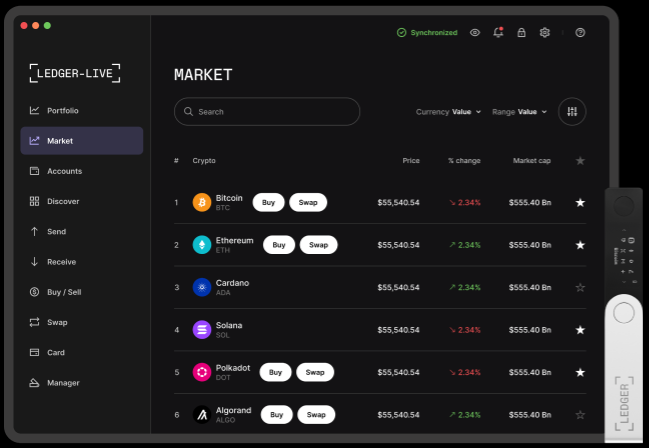
Ledger Live previously allowed users to buy crypto through partners MoonPay, Transak, Ramp, Simplex, Loopipay and Mercuryo. PayPal is the newest addition to this list. When a user purchases crypto through PayPal via Ledger Live, it is immediately sent to the user’s wallet, and no “withdrawal” process needs to be initiated by the user, the announcement stated.
Ledger chairman and CEO Pascal Gauthier claimed that combining Ledger Live with PayPal will make crypto transactions simpler while also not compromising on security:
“We’re combining the uncompromising security of Ledger with PayPal’s leadership in protected payments technology to help facilitate a seamless platform for user crypto transactions. Ledger is committed to simplifying the world of crypto and PayPal is committed to making the movement of money as simple, reliable and affordable as possible.”
Ledger claims to have sold over 6 million Ledger Nano hardware wallets since 2016, making it one of the top hardware wallet manufacturers. It came under some controversy in May, when it launched a secret recovery phrase storage service that led to confusion among users. The team later attempted to hose down criticism by clarifying how their wallet works.
PayPal announced on Aug. 7 that it is launching a stablecoin called PYUSD, but the Aug. 15 announcement does not list PYUSD as one of the coins that will be available on Ledger Live just yet.
Collect this article as an NFT to preserve this moment in history and show your support for independent journalism in the crypto space.
Update (August 16, 7:35 AM PST): This article has been updated to clarify the number of Ledger units sold.



